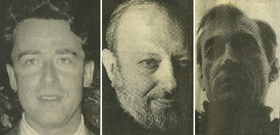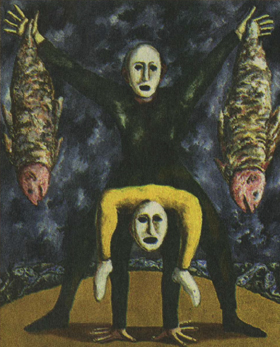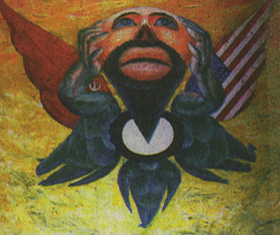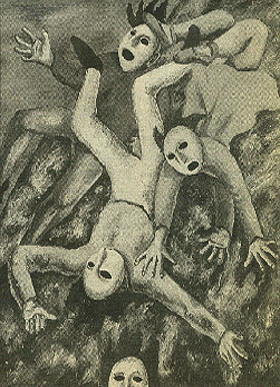FOUR RUSSIAN MESSAGES: CARNIVAL OR DRAMA?
The Sun, January, 1994
The Sun, January, 1994
| "Russian artists are coming to town and into their own" |
The practitioners of Russian contemporary art do not all belong to a specific stylistic school. Nevertheless, Nathan Berman, a New York dealer who handles many of these artists, thinks there is something about them that has great appeal for Western audiences. "Russians touch people on a very personal level," he says. "Their art tends to be very emotional, warmer, more involved. It touches the public a lot more than some of the colder, removed postmodern art in the West. Russian artists have always attempted to reach out and affect the viewer. And there is more narrative in Russian art than there Is in Western art. " Although Russian artists are becoming better known, the price of their work remains low. The Evergreen show is presented as a museum style exhibit rather than a commercial one, so the works are not for sale. However, works in the show are valued at up to $18,000 says Mr. Gertsman - inexpensive for artists with work in leading museums. Some of the Russian artists' prints sell for about $1,000, according to Mr. Levy. "Works of these people are very affordable: he says. "The majority of these artists are under-priced, in some cases by several times or more in terms of their historical importance and the quality of the art." Since much of their art was suppressed during the Soviet regime, he adds, "Most of these artists are better known in Europe and America than in their own countries. But there is a developing market over there for the art of some of these people as their importance to their own cultural history becomes so obvious." Mr. Berman says Russian banks are starting to put together collections. "Aside from realizing this may be a terrific investment, they realize It's an investment in their heritage and culture, things that give these institutions a more benevolent image." But as yet, conditions are notgood enough to produce numerous private collectors, at least not outside the major centers of the former Soviet Union. "There is not a big market in. Ukraine for art," says Dmitry Dymshits, an artist from Ukraine and chairman of a creative association called Kolir (translation: color). There is a difficult economic situation, with small earnings and high inflation. A few people in the free market are rich, and some of the rich buy pictures, but seldom”. A downtown Baltimore gallery, the Roxx Limited, is presenting a series of exhibits by Kolir artists, including a show this month featuring the work of Mr. Dymshits, Victor Savinkov, Victor Pogorelov and others. The difficulty of selling at home encourages the showing of art from the former Soviet Union and Eastern Europe in the West. In addition to the two shows currently at Evergreen and Roxx, there were recent exhibits of Soviet photography and East European ceramics presented by the Contemporary, Baltimore’s museum without walls. One hopes there will be more to come.  Alexander Gerstman, an art critic and architect, originated the idea for SAUPRA; Leonid Lamm, now living in New York, still expresses Russian artistic concerns; Nikolai Filatov's work combines futurism, irony and the rational emotional dilemma
Alexander Gerstman, an art critic and architect, originated the idea for SAUPRA; Leonid Lamm, now living in New York, still expresses Russian artistic concerns; Nikolai Filatov's work combines futurism, irony and the rational emotional dilemma |
|||
|
By John Dorsey, Art Critic They're under-priced. They're under-exposed, both here and in their homeland. But some of the world's leading museums are buying them. And now, at last, they've come to Baltimore. Long forced underground because their work was in opposition to official Soviet art, hundreds of Russian contemporary artists were known only to a few curators, dealers and collectors until the mid-1980s. Some managed to make their way to the West, where they could create in freedom. But most remained in their homeland, their work seldom seen because it couldn't find favor with government officials. Then, first with glasnost and later with the collapse of the Soviet regime, Russian contemporary art came into its, own. And it's surprised the world. "It represents the strength of the human desire for freedom of expression against great adversity," says Norton Dodge, a scholar of Soviet economics from Mechanicsville; who has amassed the leading American collection of contemporary art from the former Soviet Union. "In terms of technique, these artists are better than many Western artists because they have been trained in a very classical school. And there are some brilliant artists with some very fine unique styles. Dodge is in the process of donating his collection, some 8,000 works by about 600 artists, to Rutgers University. "Many art historians and curators look upon this movement, after the earlyRussian avant-garde" of the first part of the 20th century, "as the most significant movement in this century in Russia," says Stuart Levy, whose New York gallery is now showing the work of 40 Russian artists. As the Russian contemporary movement emerged, the cognoscenti quickly took note. Sotheby's held an auction of Russian contemporary artists in 1988 with a pre-sale estimate of $1 million. The auction brought $3.4 million. In recent years, these artists' work has entered the collections of leading museums on both sides of the Atlantic, including New York's Metropolitan, Guggenheim and Museum of Modem Art. Yet to the general public they are still unknown. A few, such as llya Kabakov, who represented Russia at the Venice Biennale last year, may be creeping into the public consciousness. But outside major centers such as New York, Russian contemporary art is still to be discovered.  The work of Natalya Nesterova has roots In surrealism.
Above, her 1991 "Transformation (Yellow Leggings)"
The work of Natalya Nesterova has roots In surrealism.
Above, her 1991 "Transformation (Yellow Leggings)"
"Four Russian Messages" represents a toe in the water for Baltimore. It includes work of Leonid Lamm, Nikolai Filatov, Natalya Nesterova and Vladimir Nemukhin, all highly regarded. It is one of a series of exhibits being presented by a New York group organized last year under the cumbersome title Society for the Advancement of Understanding Post-Modem Russian Art Inc. A privately supported non-profit foundation, SAUPRA is the brainchild of Alexandre Gertsman, an architect and art critic from Ukraine who immigrated to the USA in 1992. The Evergreen show is the group's second. The first opened in White Plains, N.Y., in November. There are plans for SAUPRA shows through 1996 at such places as the Greater Hartford Jewish Community Center and the Washington Project for the Arts. |
The Evergreen connection Evergreen is a house museum, not an art gallery. But Mr. Gertsman conSidered it a good site because of its connection with early 20th-century Russian art. Its owners in the first half of this century were diplomat John Work Garrett and his wife, art patron and collector Alice Garrett. In the early 1920s they had the house's theater decorated in designs by Leon Bakst.  Leonid Lamm ("Self-Portrait") was imprisoned in the former Soviet Union
Leonid Lamm ("Self-Portrait") was imprisoned in the former Soviet Union"He was one of the leaders of the Russian [early 20th-century) avant-garde," says Mr. Gertsman. "He' did a lot of the designs for the Diaghilev ballets in France that traveled all over the world, and he is a name that Americans know." The show is appropriate for Evergreen "as a reflection both of the collecting tastes that formed the Evergreen holdings, and of the international interests of the Garrett family," writes Lili Ott, director of Evergreen, in "the exhibit's catalog. Making Evergreen especially appropriate is the fact that the four artists are indebted to earlier 20th-century art movements, including the Russian avant-garde of such now world-famous artists as Aleksandr Rodchenko, Kasimir Malevich and Wassily Kandinsky. Mr. Filatov’s work recalls the futurists, Mr. Lamm and Ms. Nesterova have roots to some degree in surrealism, and Mr. Nemukhin's art has been linked to that of Malevich and Kandinsky. Of the four, only Ms. Nesterova still lives full-time in the former Soviet Union, in Moscow. Mr. Nemukhin divides his time between Moscow and Cologne, Germany. Mr. Lamm and Mr. Filatov are now in New York, but their work in this show reflects the concerns they had as artists in Russia. Mr. Lamm - imprisoned in the Soviet Union for three years after applying for an exit visa in the 1970s- says his works from the "Seventh Heaven" series are concerned with "a dream of flying away from a 'paradise' with cruel rules and the hope to know another paradise. They evoke the dream about another system which is more human." And Mr. Filatov, speaking through his wife, Natasha, as translator, says his work combines elements of futurism with "the sad irony about the utopian products of Russian “modernism” and the dilemma between the rational and the emotional, "which may be the dilemma of the whole of modernism.  Included in the exhibit is “Abyss,” by Natalya Nestrova
Included in the exhibit is “Abyss,” by Natalya Nestrova |
|||



